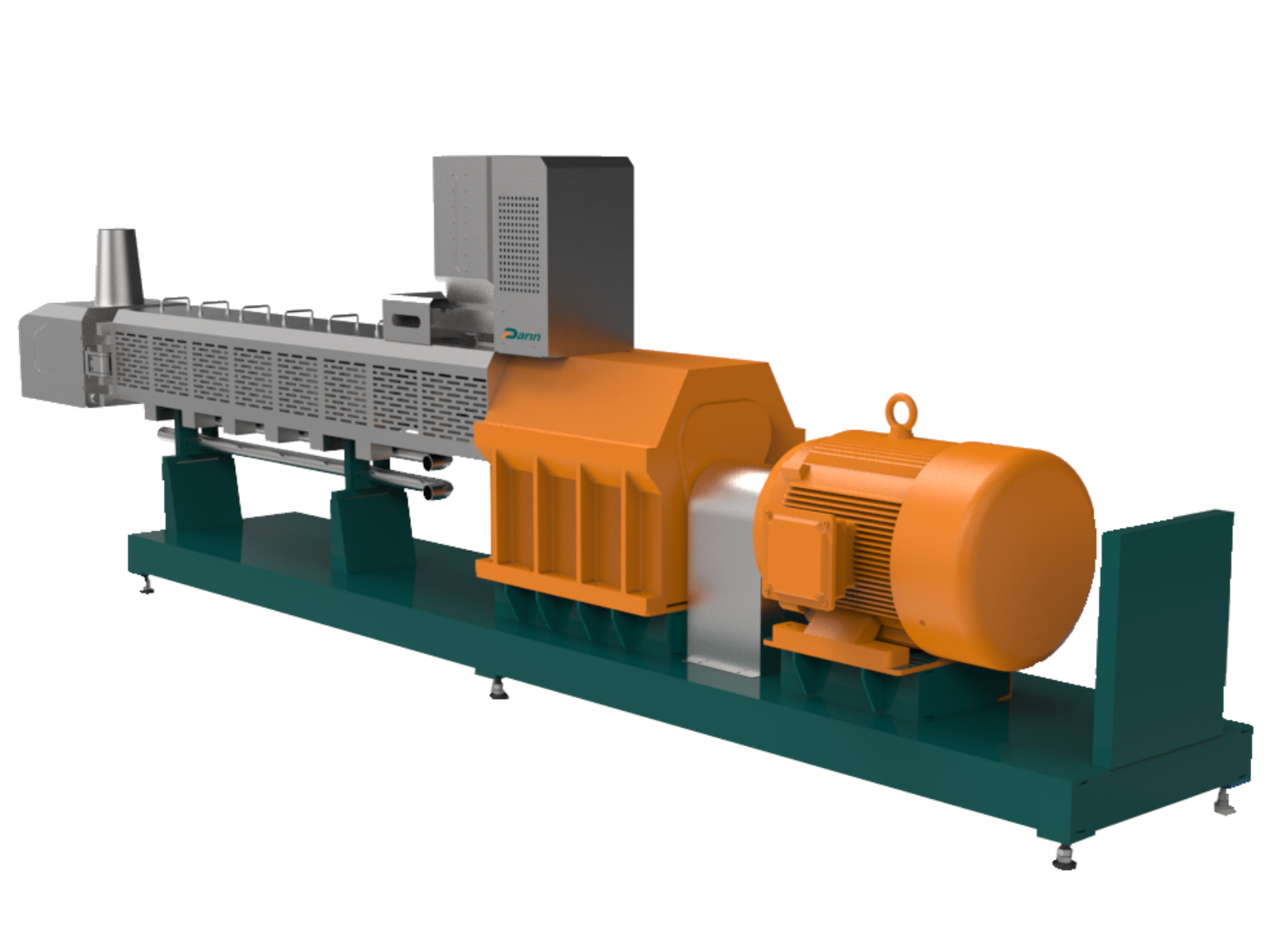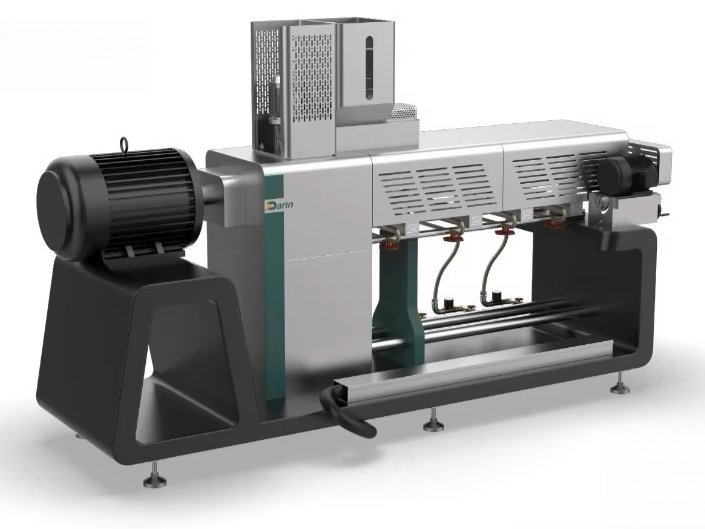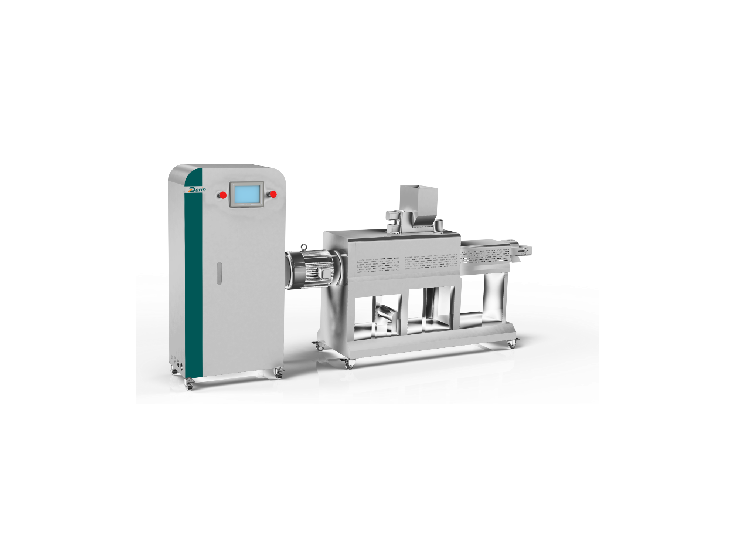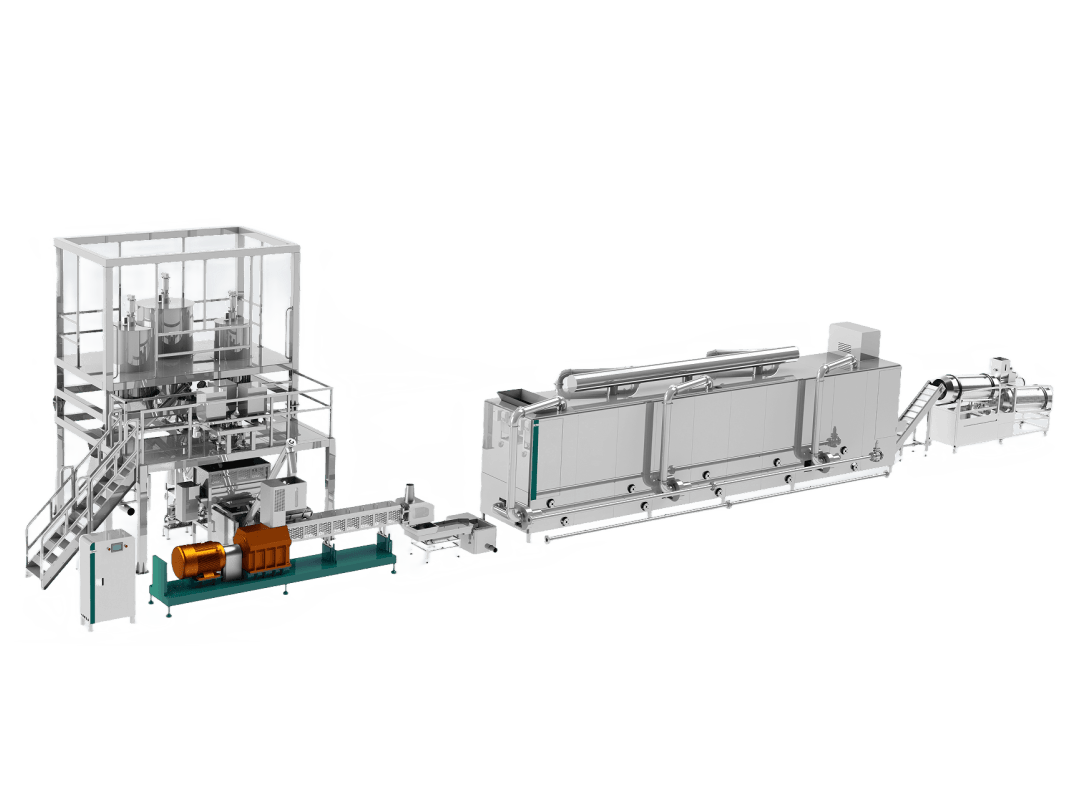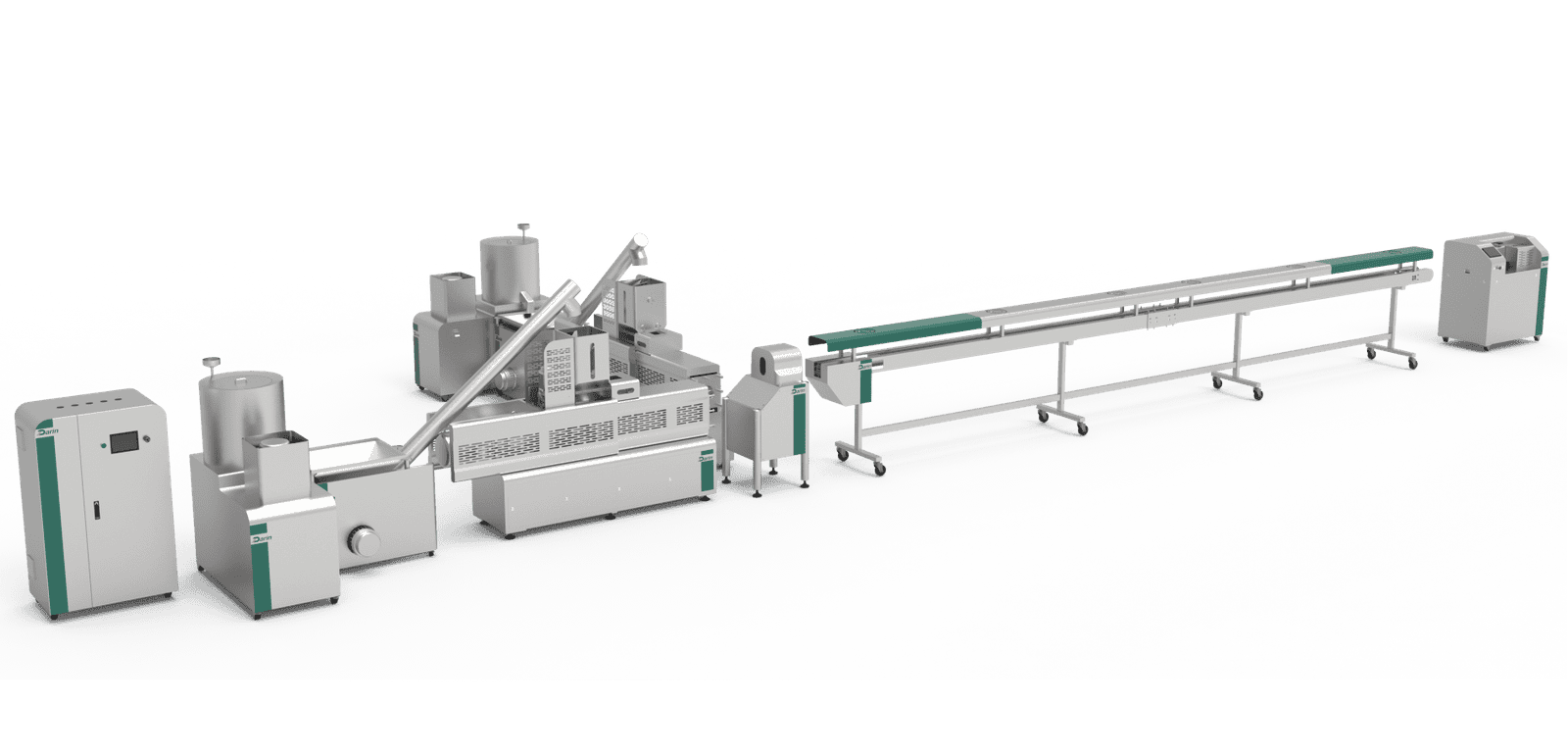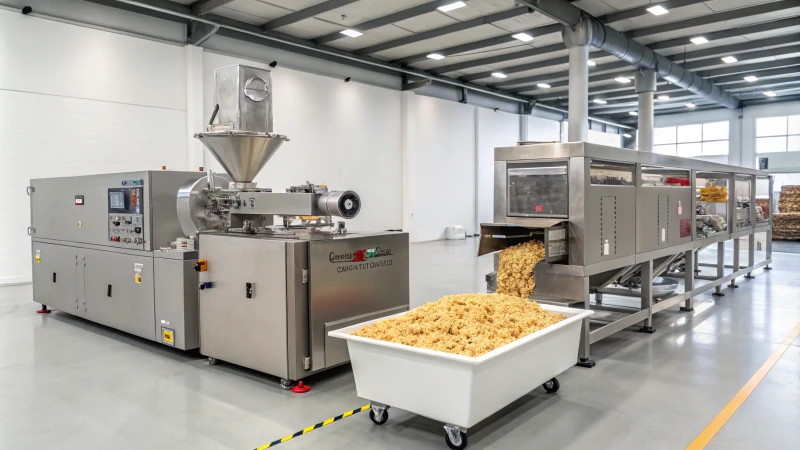
Navigating the complexities of food production machinery can be daunting, especially when deciding between single and twin screw extruders.
Single screw extruders are generally more cost-effective and simpler to operate, making them suitable for straightforward processes with less complex formulations. Twin screw extruders, however, offer superior mixing capabilities and flexibility, ideal for complex recipes and diverse product lines. The choice hinges on specific production needs and product requirements.
I remember when I first faced this decision—it felt like standing at a crossroads with countless paths stretching out before me. I knew that my choice would significantly impact my production line's efficiency and the quality of the final product. While the basic distinctions are clear, selecting the optimal extruder requires a deeper understanding of each type's operational nuances and their implications for your production process.
Let me take you through the critical factors that helped me make a well-informed decision. First, consider the complexity of your recipes. If your product line demands intricate formulations with precise ingredient mixing, a twin screw extruder might be your best bet. Their flexibility in handling a variety of materials without compromising quality is unmatched. On the other hand, if your processes are more straightforward and you’re aiming to keep costs down, a single screw extruder could be just what you need. It's simpler to operate and maintain, making it a reliable workhorse for less complex productions.
Each type of extruder brings its strengths to the table, much like choosing between two talented chefs—one excels at exquisite fusion cuisine, while the other masters traditional comfort dishes. Your choice depends on the menu you plan to serve up in your production line.
Single screw extruders are more cost-effective than twin screw extruders.Vrai
Single screw extruders have simpler designs, reducing costs.
Twin screw extruders are unsuitable for complex recipes.Faux
Twin screw extruders excel in mixing and handling complex formulations.
What Are the Main Differences Between Single and Twin Screw Extruders?
Remember the first time you faced the daunting choice between single and twin screw extruders? It's like picking the right tool for the job in a giant toolbox.
Single screw extruders are simpler and more cost-effective, ideal for straightforward applications. Twin screw extruders offer more versatility, better mixing capabilities, and are suited for complex processes, including those in pet food production.
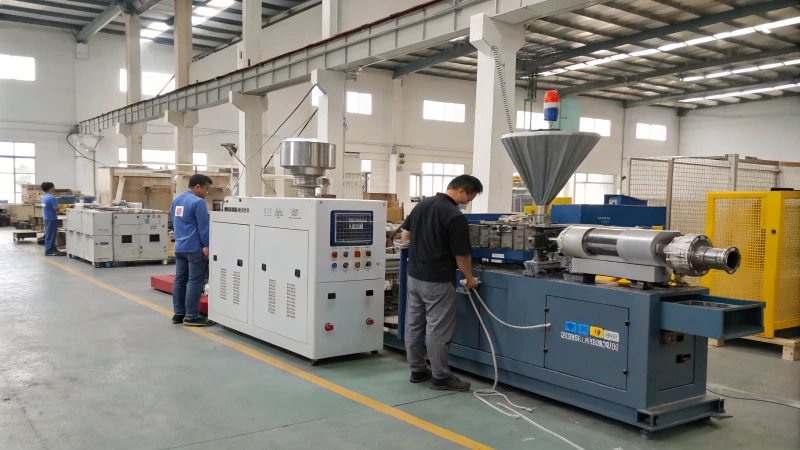
Understanding Extruder Basics
Diving into the world of extrusion was a bit like stepping into an enormous kitchen, where each tool has a unique purpose. When I first encountered these machines, I remember standing there, mesmerized by how they transformed raw ingredients into perfectly uniform products. In the pet food industry, this process is vital, as it ensures every pet treat or kibble is just right. Whether to use a vis simple1 or a twin screw extruder often depends on specific production needs.
Extrudeuses à vis unique
I recall when I first worked with a single screw extruder; its simplicity was a breath of fresh air. It reminded me of the straightforward gadgets my grandparents used—reliable and uncomplicated. These machines are perfect for projects where budget constraints are a concern or when you're just starting out and need something that's easy to maintain.
Avantages :
- Rentable : Generally less expensive, making them attractive for startups or projects with a tight budget.
- Simplicity: Easy to operate and maintain due to fewer components.
| Caractéristiques | Extrudeuse à vis unique |
|---|---|
| Coût | Plus bas |
| Maintenance | Plus facile |
| Process Complexity | Plus bas |
Extrudeuses à double vis
On the other hand, twin screw extruders are like the Swiss Army knife of the extrusion world. I remember the first time I saw one in action; it was fascinating to see its ability to handle a mix of ingredients seamlessly. This versatility is crucial for producing diverse pet food textures, making it indispensable for more advanced applications.
Avantages :
- Polyvalence : Handles a wider variety of ingredients and additives, crucial for producing diverse pet food textures.
- Efficacité du mélange : Superior mixing capabilities ensure uniformity in products like aliments de qualité supérieure pour animaux de compagnie2.
| Caractéristiques | Extrudeuse à double vis |
|---|---|
| Coût | Plus élevé |
| Maintenance | Plus complexe |
| Process Complexity | Plus élevé |
Choosing the Right Extruder
The choice between these two types of extruders often feels like selecting between a sedan and an SUV—it really depends on your journey. Considerations like budget constraints, product requirements, and the expertise of your team play pivotal roles in this decision.
- Budget Constraints: Consider initial investment versus long-term operational efficiency.
- Product Requirements: Analyze the complexity and variety of products you aim to produce.
- Operational Expertise: Determine your team’s capability to manage and maintain complex machinery.
Reflecting on my own experiences, I've found that understanding the material types and desired end-product characteristics is key to making the right choice. For those looking to delve deeper into how these machines could fit into their production line, exploring resources on technologie d'extrusion3 can offer valuable insights.
Navigating these differences can have a significant impact on both efficiency and product quality in transformation d'aliments pour animaux de compagnie4. Taking the time to align your equipment choice with your production goals is not just smart—it's essential.
Single screw extruders are more cost-effective than twin screws.Vrai
Single screw extruders have fewer components, reducing costs.
Twin screw extruders are easier to maintain than single screws.Faux
Twin screw extruders have complex components, making maintenance harder.
How Does Product Complexity Affect Your Choice of Extruder?
Imagine standing in a bustling factory, the air alive with the hum of machinery, and knowing that the right extruder can make all the difference in creating the perfect product.
Product complexity affects the choice of extruder by determining the specifications required, such as screw design, barrel length, and mixing capability. Selecting the right extruder enhances efficiency, product quality, and reduces waste.
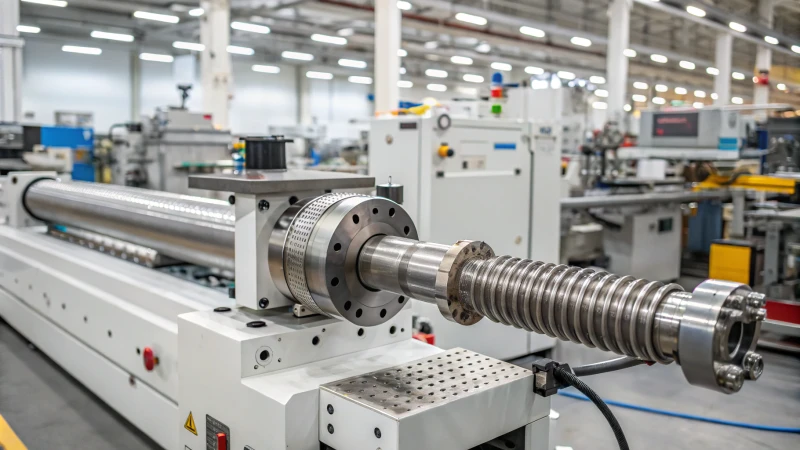
Factors to Consider in Product Complexity
When choosing an extrudeuse5, consider the intricacies of your product. Complex products often require tailored screw configurations. For instance, a pet food manufacturer might need a twin-screw extruder to handle diverse ingredients and textures.
Here's a quick overview of typical configurations:
| Type de produit | Recommended Screw Type | Caractéristiques supplémentaires |
|---|---|---|
| Aliments pour animaux | Double vis | Pre-conditioning unit |
| Spécialités | Vis double co-rotative | Enhanced mixing zones |
| Simple Snacks | Simple vis | Standard barrel length |
Importance of Extruder Specifications
The specifications of an extruder, including its screw diameter, barrel length, and die design, are pivotal when dealing with complex products. Larger screw diameters can handle higher volumes and tougher materials, making them suitable for high-capacity needs.
For example, pet snacks requiring multiple textures may benefit from a custom die design6 that allows for intricate shaping and cutting.
Material Properties and Processing Needs
Different materials exhibit unique properties during extrusion, impacting the choice of extruder. Consider how moisture content, viscosity, and thermal sensitivity affect processing. For instance, high-moisture pet foods demand specialized equipment to maintain consistency.
Implementing advanced features like contrôle de la température7 can prevent overheating and preserve nutritional value. Evaluate your product's requirements thoroughly to match with the right extruder features.
Economic Considerations in Extruder Selection
While high-complexity products may necessitate sophisticated extruders, balancing cost-effectiveness with technical requirements is crucial. Calculate potential ROI by assessing how an extruder's efficiency can save on operational costs. Compare initial investment against long-term savings in waste reduction and quality improvement.
Opt for machines with modular upgrades to future-proof your investment and adapt to evolving production needs.
In summary, comprehensively assessing product complexity ensures that your choice of extruder supports optimal processing conditions, scalability, and product consistency.
Twin-screw extruders are ideal for simple snacks.Faux
Simple snacks typically use single-screw extruders due to less complexity.
High-moisture foods need specialized extrusion equipment.Vrai
Specialized equipment maintains consistency in high-moisture food extrusion.
How Do Different Extruder Types Impact Costs?
Choosing the right extruder can feel like picking the perfect tool for your life's work. It's not just about the bells and whistles; understanding the cost implications can steer you toward smarter choices.
Extruder costs vary by type, including initial purchase price, maintenance, and operational efficiency. Twin-screw extruders generally have higher initial costs but offer greater flexibility and efficiency than single-screw extruders.
| Facteur de coût | Extrudeuses à vis unique | Extrudeuses à double vis |
|---|---|---|
| Coût d'achat initial | Plus bas: Generally less expensive to purchase initially. | Plus élevé: More complex design leads to higher upfront costs. |
| Installation Costs | Plus bas: Simpler setup and space requirements. | Plus élevé: Requires more precise installation and space. |
| Coûts de fonctionnement | Plus bas: Typically consume less energy for basic operations. | Plus élevé: More energy-intensive due to additional screws. |
| Coûts de maintenance | Plus bas: Fewer components result in easier maintenance. | Plus élevé: More parts and complexity increase maintenance needs. |
| Polyvalence | Limitée: Best suited for simpler extrusion tasks. | Plus élevé: Capable of handling a wider variety of products and formulations. |
| Qualité des produits | Adéquat: Suitable for standard products with consistent quality. | Supérieure: Provides better mixing, texture, and product uniformity. |
| Efficacité de la production | Bon: Efficient for high-volume, low-complexity products. | Excellent: Optimized for both high volume and complex products. |
| Flexibilité dans le traitement | Limitée: Less adaptable to changes in product formulations. | Haut: Easily adjustable for different recipes and processing conditions. |
| Consommation d'énergie | Plus bas: More energy-efficient for straightforward processes. | Plus élevé: Increased energy usage due to enhanced capabilities. |
| Besoins en espace | Compact: Takes up less floor space. | Plus grand: Requires more space due to additional components. |
| Longevity and Durability | Bon: Durable for standard applications. | Excellent: Built to withstand more demanding processing conditions. |
| Training and Operation | Plus simple: Easier to train operators for basic tasks. | Plus complexe: Requires more training for optimal use. |
| Coût total de possession | Plus bas: Generally more cost-effective over the equipment’s lifespan for simple tasks. | Plus élevé: Greater upfront and ongoing costs, justified by enhanced capabilities and flexibility. |
Initial Purchase Costs
When I was first diving into the world of extrusion machinery, the price tags were a real eye-opener. The initial cost of extruders can vary greatly, depending on what you're looking for. For instance, extrudeuses à double vis8 usually come with a higher upfront price compared to their single-screw counterparts. But here's why: they pack in a lot more features, allowing for more versatile processing and consistent product quality. Let's break it down:
| Type d'extrudeuse | Approximate Cost Range |
|---|---|
| Simple vis | $20,000 - $100,000 |
| Double vis | $50,000 - $250,000 |
Efficacité opérationnelle
Thinking back to my first major investment in machinery, I learned quickly that the sticker price isn't the whole story. Twin-screw extruders might seem pricey at first, but they often end up saving you money in the long run thanks to their improved mixing capabilities and des taux de production plus élevés9. On the flip side, single-screw machines can struggle with complex materials, which might hike up your costs per unit if you're not careful.
Entretien et longévité
Maintenance is one of those hidden costs that I had to learn about the hard way. Twin-screw extruders are a bit like high-maintenance friends—they require more attention but pay off in big ways. They handle diverse formulations efficiently, which can eventually offset their higher maintenance costs. Here’s how they compare:
| Type d'extrudeuse | Coûts de maintenance | Durée de vie moyenne |
|---|---|---|
| Simple vis | Modéré | 15-20 years |
| Double vis | Haut | 10-15 ans |
Consommation d'énergie
Energy consumption is another key factor that can catch you off guard if you're not prepared. Twin-screw systems10 tend to consume more energy because of their advanced functionalities. However, with smart management, these costs can be balanced out by reduced material wastage and better product quality.
In wrapping up my journey through this extruder maze, I've found that while single-screw extruders are easier on the wallet initially, twin-screw options often justify their higher overall expenditure with their efficiency and consistency. Understanding these cost factors has been crucial in making informed decisions about which extruder best fits my business needs.
Twin-screw extruders have higher initial costs than single-screw.Vrai
Twin-screw extruders cost $50,000-$250,000; single-screw $20,000-$100,000.
Les extrudeuses monovis sont plus économes en énergie que les extrudeuses bivis.Vrai
Single-screw extruders consume less energy due to simpler design.
How Do Extruder Types Influence Product Quality and Consistency?
Remember that time you tried a new recipe, and it just didn't taste right? Turns out, the type of extruder you use in manufacturing is a bit like choosing the right kitchen tool.
Extruder types influence product quality and consistency by affecting factors such as texture, moisture retention, and ingredient integration. Different extruders offer varying levels of control over these aspects, impacting overall production efficiency.
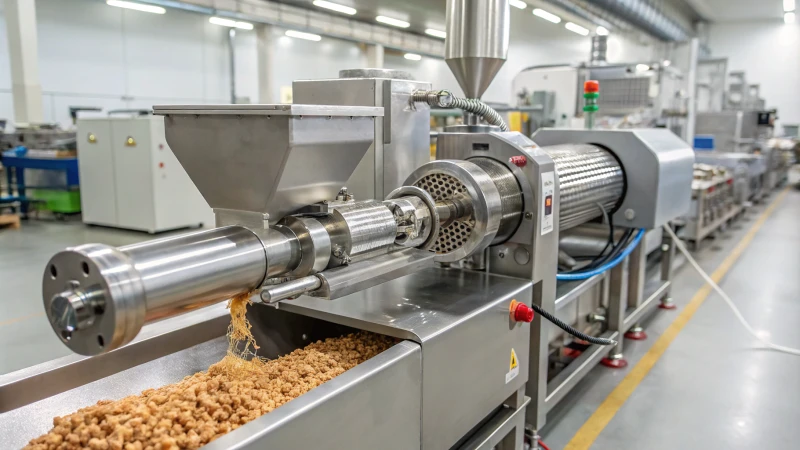
Comprendre les types d'extrudeuses
When I first dove into the world of manufacturing, I had no idea just how pivotal extruders would become. Imagine them as the master chefs of the industrial kitchen, turning raw materials into the delicious final products we all rely on. In my journey with production d'aliments pour animaux de compagnie11, I've learned that there are primarily two types of extruders: single-screw and twin-screw, each with its own set of unique traits that impact product quality and consistency.
Extrudeuses à vis unique
Single-screw extruders remind me of those trusty tools we all have in our kitchens—simple and effective. They're great for handling low-moisture ingredients, much like a basic blender that can whip up a smoothie but struggles with thicker mixtures. The downside? Their mixing capability12 isn't top-notch, which can sometimes lead to an uneven spread of ingredients. Think of it as biting into a cookie and finding all the chocolate chips clustered in one spot.
Extrudeuses à double vis
On the flip side, twin-screw extruders are like those fancy multi-functional kitchen gadgets that do it all. With their superior mixing and shearing capabilities, they can handle a variety of ingredients, ensuring everything is evenly distributed. It's like baking a cake where every slice is as moist and flavorful as the last.
| Paramètres | Simple vis | Double vis |
|---|---|---|
| Coût | Plus bas | Plus élevé |
| Capacité de mélange | Limitée | Excellent |
| Polyvalence des ingrédients | Faible | Haut |
| Cohérence des produits | Variable | Cohérent |
Impact sur la qualité des produits
It's fascinating how the choice between these extruders can make or break the physical and nutritional quality of aliments pour animaux13. I've seen firsthand how twin-screw extruders provide precise control over temperature and pressure. This is crucial because maintaining nutrient integrity during processing isn't just a technical detail; it's what ensures our pets get the best from their meals.
Consistency in Manufacturing
Consistency isn't just a buzzword in manufacturing; it's the bedrock of customer satisfaction. Twin-screw extruders shine here, maintaining uniformity in shape, size, and density across each batch. It's like ensuring every single cookie in a batch comes out perfectly round and chewy—a true mark of quality that stands up to even the strictest industry regulations.
Considerations for Choosing an Extruder
Choosing between single and twin-screw extruders isn't just about cost or complexity. It's about aligning your choice with your production goals. For me, understanding the scale of production, ingredient types, and desired product characteristics has been key to making informed decisions. It reminds me of choosing the right oven for a bakery: get it right, and you'll consistently turn out perfect pastries.
By carefully weighing the strengths and limitations of each extruder type, I've been able to align my equipment choices perfectly with my production goals, enhancing both manufacturing efficiency14 and product quality.
Single-screw extruders have limited mixing capability.Vrai
Single-screw extruders are cost-effective but offer limited mixing.
Twin-screw extruders are less versatile with ingredients.Faux
Twin-screw extruders handle a wide range of ingredient types.
Which Extruder Offers Better Versatility for Your Product Range?
When I first dipped my toes into the world of extruders, it was like stepping into a realm where endless possibilities for creativity and innovation awaited.
The extruder offering the best versatility typically depends on specific industry needs. For 3D printing, direct drive systems provide greater material flexibility, while in food production, twin-screw extruders offer adaptability across different products.
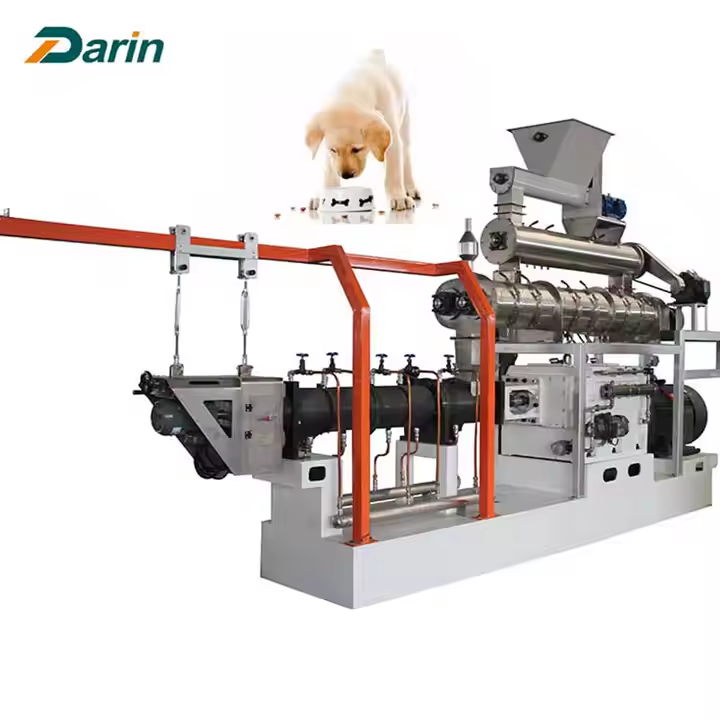
Comprendre les types d'extrudeuses
Picture this: you're on the brink of launching a new product line, and the choice of extruder could be the game-changer. In 3D printing, it's like choosing between speed and finesse. Direct Drive systems are akin to having a versatile artist at your fingertips, perfect for materials that demand precision and elasticity like TPU and TPE. Meanwhile, Bowden systems bring to mind a sprinter in full stride, optimizing for speed with lighter loads.
In food processing, my journey led me to the intriguing world of monovis versus bi-vis extruders. Imagine trying to create a culinary masterpiece with limited tools—that’s the single-screw extruder. But with a twin-screw, it's like having a fully stocked kitchen, ready to whip up anything from pet snacks to gourmet cereals.
| Fonctionnalité | Direct Drive | Bowden | Double vis |
|---|---|---|---|
| Material Versatility | Haut | Modéré | Haut |
| Vitesse | Modéré | Haut | Variable |
| Complexity Handling | Faible | Faible | Haut |
Industry-Specific Needs
As someone deeply immersed in pet food manufacturing, I've witnessed firsthand the magic of twin-screw extruders. They're not just machines; they're culinary wizards capable of crafting diverse textures and compositions. They allow me to experiment and innovate with pet snacks by tweaking moisture content and texture15, thus opening doors to a broader product spectrum.
On the flip side, when I venture into the fast-paced world of 3D printing, it's the direct drive extruders that steal the spotlight. They offer unparalleled precision and can handle flexible materials essential for creating bespoke designs. It’s like having a tailor who can stitch the finest garments to fit any form.
Innovations technologiques
Today’s extruders are not just about function but also finesse. With advancements such as systèmes de contrôle automatisés16, I can ensure every batch of food extrusion maintains consistent quality—an absolute must when serving discerning markets across the globe. And in 3D printing, dual-extruder setups have become my playground for creativity, enabling me to explore multi-material masterpieces.
Choosing the right extruder is like selecting a dance partner who matches your rhythm. By aligning with your specific industry needs and embracing cutting-edge innovations, you can ensure your choice supports your aspirations and market demands seamlessly.
Direct drive extruders offer high material versatility.Vrai
Direct drive systems can handle flexible materials like TPU and TPE.
Bowden extruders excel in handling complex materials.Faux
Bowden systems are not ideal for flexible materials due to retraction issues.
What Operational Factors Should Be Considered When Choosing an Extruder?
Choosing the perfect extruder feels like picking the right tool for a job that demands precision and efficiency.
When choosing an extruder, consider factors like production capacity, material compatibility, energy efficiency, and maintenance requirements. These elements significantly impact operational efficiency and cost-effectiveness in manufacturing processes.

Capacité de production
When I think back to my early days in the industry, I remember the struggle of managing production with underperforming equipment. Understanding your required production capacity is fundamental when selecting an extruder. Evaluate your daily output needs and ensure the extruder can consistently meet these demands without compromising la qualité des produits17. Overloading an extruder can lead to inefficiencies and increased wear, affecting long-term operational costs.
| Plage de capacité | Recommended Usage |
|---|---|
| Low (1-5 tons/day) | Small-scale operations |
| Medium (5-20 tons/day) | Mid-sized manufacturers |
| High (20+ tons/day) | Large-scale production |
Compatibilité des matériaux
Imagine you're trying to bake a cake using a blender meant for smoothies—it might work, but it's not ideal. Similarly, the materials used in manufacturing play a significant role in choosing an extruder. Different materials require specific screw configurations and processing conditions. Ensure the extruder is designed to handle your materials efficiently. For example, high-fat content in pet food requires specific conceptions de vis18 to prevent clogging and ensure consistent flow.
Efficacité énergétique
Energy bills can be a real pain, right? Energy consumption is a critical factor affecting operational costs. Modern extruders offer energy-efficient solutions that can significantly reduce power usage. Look for machines with variable frequency drives (VFDs) that adjust motor speed to match production requirements, enhancing économies d'énergie19.
Maintenance and Reliability
I’ve learned the hard way that regular maintenance is necessary to keep extruders running smoothly. Opt for models with easy-to-replace parts and accessible designs to minimize downtime. Evaluating the manufacturer's reputation for l'assistance après-vente20 is also crucial, as it ensures you receive timely assistance when needed.
Manufacturer Support and Reliability
Choosing a reliable manufacturer is like having a trustworthy friend—you know they have your back. Investigate the manufacturer's history, customer reviews, and availability of spare parts. Manufacturers with a global presence often provide better support and quick access to service centers21.
High production capacity extruders suit small-scale operations.Faux
High capacity is meant for large-scale production, not small-scale.
Les extrudeuses à haut rendement énergétique réduisent considérablement les coûts d'exploitation.Vrai
Energy-efficient designs lower power usage, cutting costs.
Conclusion
Choosing between single and twin screw extruders for food production depends on budget, complexity of recipes, and desired product quality, impacting efficiency and operational costs.
Explore the fundamental uses of single screw extruders to understand their benefits in specific applications. ↩
Learn about how twin screw extruders enhance pet food manufacturing processes. ↩
Gain insights into extrusion technology's role in modern food processing. ↩
Understand how extruders are pivotal in enhancing pet food production efficiency. ↩
Explore various extruder types to find one that suits complex manufacturing needs efficiently. ↩
Learn about custom die designs to enhance product shaping and performance. ↩
Discover how temperature control can maintain product quality during extrusion. ↩
Learn how twin-screw extruders enhance processing capabilities and product quality, justifying their higher initial costs. ↩
Explore why twin-screw extruders often lead to higher output rates, impacting overall production efficiency. ↩
Understand how energy consumption impacts long-term costs for twin-screw extruders compared to single-screw options. ↩
Learn about various extruders used in pet food production to choose the best for your needs. ↩
Discover the mixing capabilities of single-screw extruders to understand their limitations. ↩
Explore how extrusion affects the nutritional quality of pet food to enhance product value. ↩
Understand how selecting the right extruder can boost manufacturing efficiency and output quality. ↩
Discover how twin-screw extruders can manage moisture content, vital for diverse pet snack production. ↩
Learn about technological advancements that enhance food extrusion processes, ensuring quality and efficiency. ↩
This link elaborates on why maintaining product quality is crucial when operating an extruder, providing insights into potential challenges. ↩
Learn about specific screw designs needed for high-fat content materials, crucial for efficient extruder operation. ↩
Explore energy-efficient extruders equipped with variable frequency drives (VFDs) to optimize power consumption. ↩
Discover why reliable after-sales support is vital for maintaining machinery efficiency and reducing downtime. ↩
Find out how a manufacturer's service centers can enhance support and reliability for extruder users. ↩


